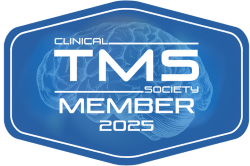
Transcranial magnetic stimulation (TMS) is a new treatment for perinatal depression that addresses a current need in the U.S. identified by the American Psychological Association (APA). In 2018, the APA published a short press release called “Position Statement on Screening and Treatment of Mood and Anxiety Disorders During Pregnancy and Postpartum.” The APA releases position statements when its members reach consensus that a current public health problem is underrecognized by the general public and healthcare providers. Here’s how the position statement begins:
“The incidence of mood and/or anxiety disorders in the antenatal and postnatal periods is surprisingly high in the United States and has become a serious public health problem.”
In an interview in the online journal Psychiatric News, one of the physicians who crafted the position statement, Jennifer L. Payne, M.D., director of the Women’s Mood Disorders Center at Johns Hopkins School of Medicine, elaborates further:
“Perinatal depression is one of the most common complications of giving birth. We want to make abundantly clear the seriousness of these disorders and explain how we must address them to avoid deleterious effects on infant development, including preterm birth, low birth weight, lower IQ, slower language development, and more child behavioral problems. It impacts more than just the mom. It really becomes a public health problem in a way—it becomes about the whole family.”
This article will focus on one of the disorders Dr. Payne mentions: perinatal depression. We recently published an article on a related topic – postpartum depression – that focuses on a specific aspect of perinatal depression that occurs after a baby is born. To read that article, please navigate to the blog section of our website and read this article:
Transcranial Magnetic Stimulation (TMS) for Post-Partum Depression
This article will focus on depressive disorders that develop during pregnancy, once called pre-partum depression, which are now classified as perinatal depression, alongside prepartum and postpartum depression. Although these three types of depression are related – by proximity in time – to pregnancy and childbirth, each has slightly different characteristics. As we mention, this article will focus on depression that occurs before pregnancy, since our previous piece focused on depression that occurs after childbirth
What is Perinatal Depression?
The National Institute of Mental Health (NIMH) defines perinatal depression – also called peripartum depression – as follows:
“Perinatal depression is a mood disorder that can affect women during pregnancy and after childbirth. Perinatal depression is diagnosed when at least five depressive symptoms are present for at least 2 weeks. The diagnosis includes either depression or anhedonia in addition to the five symptoms to be diagnosed. Perinatal depression includes depression that begins during pregnancy and depression that begins after the baby is born.”
What that means is that is major depressive disorder that begins during pregnancy or within a month of delivery. In addition to the typical symptoms of depression, the Centers for Disease Control (CDC) indicate that people with PDD may experience the following.
Perinatal Depression: Signs and Symptoms
- Persistent feelings of sadness/emptiness
- Irritability
- Persistent feelings of guilt, worthlessness, hopelessness, or helplessness
- Declining interest in hobbies/activities
- Extreme fatigue
- Restlessness
- Problems with memory, concentration, and/or decision-making
- Sleep problems: too little or too much
- Uncharacteristic changes in weight and/or eating habits
- Physical ailments – aches, pains, headaches, nausea – that have no clear cause and don’t respond to typical treatment
- Difficulty bonding /forming attachment to newborn
- Persistent worry/doubt about the ability to care for newborn
- Persistent thoughts of death, suicide, or harming oneself or newborn
- Thoughts of harming the newborn
Risk factors for depression include but are not limited to genetics, a family/personal history or depression, significant injury/ illness, stress, alcohol or substance use disorder. Those risk factors apply to perinatal depression, along with these risk factors, which are specific to perinatal depression.
- Insufficient social support
- Insufficient family support
- Difficulty getting pregnant
- Having more than one child: twins, triplets, or more
- Giving birth as a teenager
- Pre-term labor/birth, i.e. before 37 weeks
- Medical problems during pregnancy or delivery
Those are the primary symptoms and risk factors of perinatal depression that everyone should know about and watch for in new and/or expecting mothers. When we say watch for, we encourage people that advice seriously. Please reread the APA position statement at the beginning of this article carefully.
Pay close attention to the stated consequences of untreated perinatal depression for the infant after birth:
- Preterm birth
- Low birth weight
- Low IQ
- Impaired language development
- Increased behavioral problems
In addition, we should all understand and recognize the consequences for the mother, which include impaired ability to carry out daily tasks, difficult and distressing emotions, and extreme behavioral problems, up to and including suicidal ideation and increased risk of suicide.
At this point, the preponderance of evidence makes it clear that perinatal depression is a serious issue, with a broad range of negative consequences for both mother, infant, and family.
How Common is Perinatal Depression?
To understand these prevalence rates in context, we’ll start with the overall rates of depression in the U.S. Data from the 2021 National Survey on Drug Use and Health (2021 NSDUH) shows the following.
Depression Among Adults 18+
- 8.4% of total population (21 million)
- 10.5% of females (13.4 million)
- 6.2% of males (7.6 million)
- 6.0% reported depression with severe impairment (14.4 million)
- 7.2% of females (9.3 million)
- 4.1% of males (5.1 million)
Those numbers give us perspective and help create context for the prevalence rates of perinatal depression. Now let’s narrow our focus and look at rates of perinatal depression as indicated in a report on maternal health factors published by the CDC for the years 2016-2020.
Perinatal Depression: 2016-2020
Depressive Symptoms 3 Months Before Pregnancy
- 2016: 12.3%
- That’s 35,670 mothers
- 2020: 15.5%
- That’s 41,276 mothers
Those figures show a 15.7 percent increase.
Depressive Symptoms During Pregnancy
- 2016: 11.6%
- That’s 35,336 mothers
- 2020: 15.2%
- That’s 40,920 mothers
Those figures show a 15.8 percent increase.
Depressive Symptoms After Pregnancy
- 2016: 12.8 %
- That’s 35,081 mothers
- 2020: 13.4%
- That’s 40,691 mothers
Those figures show a 15.9 percent increase.
These figures tell us that among the 4 million children born each year in the U.S., the number of mothers with perinatal depression is increasing at a rate of 3 percent a year, which is cause for alarm – especially when we consider the severe consequences of untreated perinatal depression for the mother, the child, and the family.
With the problem clearly defined, let’s look at new data on an innovative new treatment for perinatal depression: transcranial magnetic stimulation (TMS).
Treatment for Perinatal Depression: Traditional Approaches
Traditional treatment for perinatal depression is the same as treatment for standard major depressive disorder (MDD). The standard approach includes traditional modes and complementary approaches, such as:
- Psychotherapy:
- Cognitive behavioral therapy (CBT)
- Dialectical behavior therapy (DBT)
- Acceptance and commitment therapy (ACT)
- Antidepressant medication:
- SSRIs
- Lifestyle changes:
- Exercise and activity
- Healthy eating
- Sleep hygiene
- Complementary modes:
- Community support groups
- Mindfulness practices
- Massage
- Yoga
- Acupuncture
However, evidence shows that close to 30 percent of people with depression don’t experience symptom relief with these approaches to treatment. There is also a risk of negative consequences for the fetus/infant associated with antidepressant medication. That’s why many women with perinatal depression defer treatment: they worry it may harm their child.
Treatment for Perinatal Depression: Transcranial Magnetic Stimulation (TMS)
The treatment we mention above – transcranial magnetic stimulation (TMS) – is an important option that women with perinatal depression need to know about. TMS is a safe, effective therapy approved by the Food and Drug Administration (FDA) for the treatment of several mental health diagnoses, including, but not limited to:
- Depression
- Treatment-resistant depression
- Depression with suicidal behavior
In almost all cases, TMS is delivered in an outpatient setting. TMS is non-invasive, and uses electromagnetic pulses delivered by a small coil or cap that stimulate areas of the brain associated with depression. In contrast to other approaches to depression treatment:
- TMS has no systemic side effects
- Many patients report symptom relief within one week of initiating treatment
- Symptom relief may persist for up to 6 months after treatment
Those characteristics make TMS a viable treatment alternative for women with perinatal depression. But what makes TMS most appropriate are the clinical results. A random controlled, double-blind study conducted on pregnant women with MDD treatment with TMS between week 14 and 34 of pregnancy showed:
- 75% of women who received TMS reported symptom relief
In another study of pregnant women with depression, expecting mothers received 5 TMS sessions per week for 4 weeks with the following results:
- Reduced depressive symptoms
- No side effects
- No obstetric complications
That’s the latest evidence for the use of TMS for women with perinatal depression. We should add this reminder: this information is for depression that occurs before birth, which is one component of perinatal depression. A great deal of evidence exists for the use of TMS for post-partum depression. To read those studies, please refer to the link above to our previous article, Transcranial Magnetic Stimulation (TMS) for Post-Partum Depression.
Helping Mothers and Children Helps Us All
We cannot overstate the importance of maternal health, which includes maternal mental health. During pregnancy and the postpartum period, women are at increased risk of developing mental health disorders, including depression, anxiety, and others. These diagnoses can have serious and persistent negative effects on everyone involved, including the mother, the child, and the rest of the family.
To address and – ideally – prevent the negative outcomes associated with perinatal depression and other mental health diagnoses, the APA included the following recommendations in the position paper we mention above.
American Psychological Association (APA): 7 Action Steps to Protect Maternal Mental Health
- Clinical providers should assess all pregnant and postpartum women for symptoms and risk factors psychiatric disorders.
- Clinical providers should educate perinatal patients about the symptoms of depression, anxiety, and psychosis.
- Clinicians should evaluate all perinatal patients for depressive, anxiety, and psychotic disorders during the entire pregnancy and throughout the postpartum period.
- Clinical providers should use a validated screening tool to assess depression at least twice during pregnancy:
- First, during early pregnancy, to assess the presence or absence of preexisting psychiatric diagnoses
- Second, during the later phases of pregnancy
- In addition, clinicians should screen for mental health disorders during pediatric visits for at least six months after childbirth.
- Clinicians should create a system for responding to mental health screens to ensure patients receive appropriate, timely, evidence-based treatment and support.
- Psychiatrists should educate perinatal patients about the dangers of untreated psychiatric conditions.
- Psychiatrists should educate perinatal patients about the risks and benefits of psychiatric medication during pregnancy or while breastfeeding.
We think the APA has this exactly right. That list of recommendations is achievable. It’s within reach of every healthcare provider we can think of, from primary care physicians to women’s health specialists to mental health treatment providers. And – based on the information in the recent studies on the effectiveness of TMS for perinatal depression – we encourage providers to consider TMS as a realistic alternative to traditional mental health treatment for perinatal patients.


